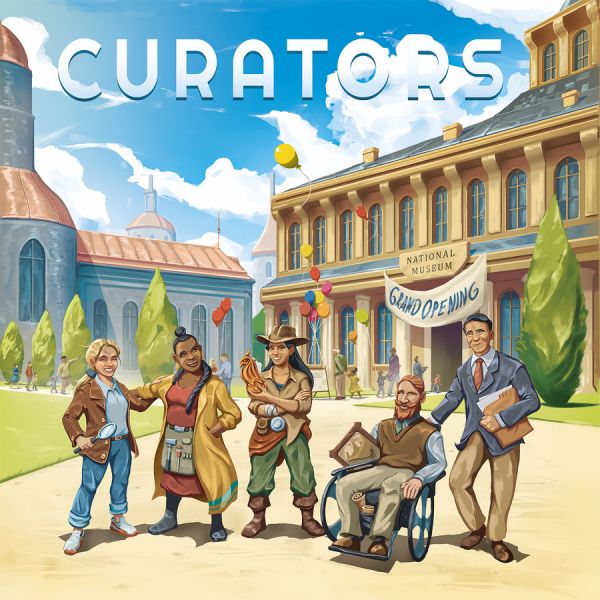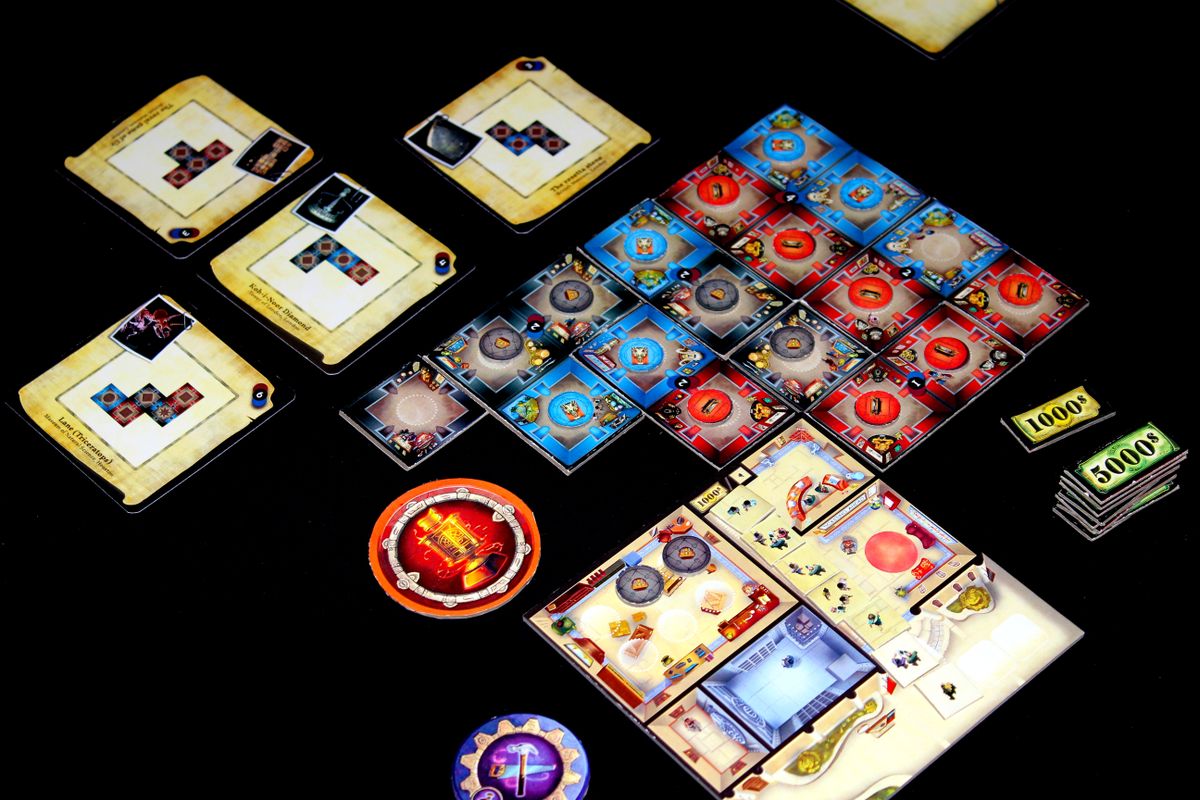Curators Challenges You to Build the Most Prestigious Museum

Curators combines worker action and tile placement in a glorious chain of economical gain as players try to win the coveted award for Museum of the Year.
Gameplay
Curators is a 1-4 player game that promises a Euro experience in a casual package. Players begin with a museum entrance and $4,000 as seed money. The board contains a spiral of tiles with red, blue, and black spaces (the number of tiles is determined by the player count, and tiles note which are used in those player counts). The tiles will be used to construct wings within each player’s museum. There is also an auction house board where objects will be placed throughout the game to be bought for placement in one’s museum.
Actions are completed by using five double-sided worker chips, each able to perform a specific task. Carpenters allow players to take one of the displayed museum wing tiles (the first one is free, the second costs $1,000, the third $2,000 and so on) and add it to their museum entrance. Museum tiles must either be added to ones already constructed or to one of the doors for the wings displayed on the museum entrance board. Archaeologists allow players to collect objects for display in their museum wings. Players will choose a colored object (red, blue, or black to match the colors of the museum wings) to add to their storage and another of the same color to be added to the auction house. Collection Managers can buy objects from the auction house. Restorers allow players to display the objects they’ve collected in their museum wings, which gain more visitors to their museum. Financial Managers allow players to collect money from each visitor at their museum. When played, action chips are turned over to reveal a different worker action from the remaining four action types, which may allow for double actions if a player can meet the requirements. For example, if a player has two carpenters, they can build two wings onto their museum if they are able to pay the costs of those tiles.
Another aspect of building wings involves fulfilling contracts. Players begin with two contracts that show a pattern to complete and the corresponding objects necessary to complete the contract for end game victory points. Filling wings with objects as players advance through the game is also important, because filling any complete wing tile(s) will attract new visitors, which will allow players to gain more contracts.
Once the last museum wing tile has been claimed, players will have two more rounds to complete any actions before the game ends. Points are determined by adding up completed contracts, completed wings, objects on a wing, and points from money (1 point for every $4,000). The player with the most points is declared the winner!

Photo by Erik Yurko, licensed under CC BY-NC-SA 3.0.
Review
Curators does a great job balancing some higher-end mechanics and actions with simplicity. Though new players may see the game as having an entry barrier, the rulebook is well-written and laid out, not to mention just a few pages. Anyone who sees the word “Euro-like” and worries that Curators may be too heavy for them can rest assured that its normal gameplay is quick, easy to learn, and most of all -- fun.
The worker action chips will be where players find the real fun. Much like a simple engine builder when everything starts to combo and feel rewarding, players will find the same experience when they pull off a double action with two of the same worker chips to maximize their turns. Though there seems to be a lot going on in the game, it becomes relatively simple and easy to set up turns to build museum wings, populate them with objects, fulfill contracts, attract visitors, and collect money. Everything works seamlessly and smoothly, and for casual gamers it becomes joyful to just let the game come to them at their own pace. No one can monopolize any actions, spaces or goods. This allows players plenty of options during their turns without feeling hamstrung into actions that don’t benefit them.
These actions are also relevant to the game’s theme. While museums and curation seems to be a theme on the rise, Curators maximizes it well. It’s not completely immersive, but it does feel like each worker chip is a part of your own tiny museum and the sense of accomplishment with building a museum and fulfilling contracts has similarities with the machinations of small museums. The aesthetics of the game don't detract from this sense of immersion, however we felt that the art style in general seemed a bit dated and could be improved for future editions.
Curators also offers some advanced rules, which can be added to a game to change the gameplay for players who are looking for different challenges. These do not necessarily ratchet up the difficulty, but it may be for players who are looking at a casual game as a gateway to more traditional lightweight Euro experiences.
Overall, Curators does well in meshing its mechanics into a cohesive and thematic experience. It does land on the "heavier" side of casual games, but its well-worn mechanisms are familiar in family-weight games (simple worker placement/action, tile-laying) so the on-ramp to playing and enjoying Curators is not steep.
Curators successfully funded via Kickstarter recently and has now opened its late pledge manager.
Pros: Variable actions per turn, casual gameplay with the ability to introduce players to nuanced mechanics, meshes thematics and mechanisms well, well-written and organized rulebook
Cons: Art style is a little dated




